

At the end of 2022, the fashion world lost another of its legendary figures whose career spanned five decades, influencing every generation she walked along with.

Fashion designer and activist Vivienne Westwood passed away on December 29, 2022
Dame Vivienne Westwood was recognised as a global fashion designer and co-creator of the UK punk style. However, in some aspects, she was even more famous for being an activist. Trying to summarise all the activism initiatives she embraced all over the world does not give justice to her proactive approach. While we wonder if prominent fashion designers and top brands are ready to carry on the legacy of this great fashion maverick, here we will try to provide some significant examples to show how activism ruled Vivienne Westwood’s life as much as design.
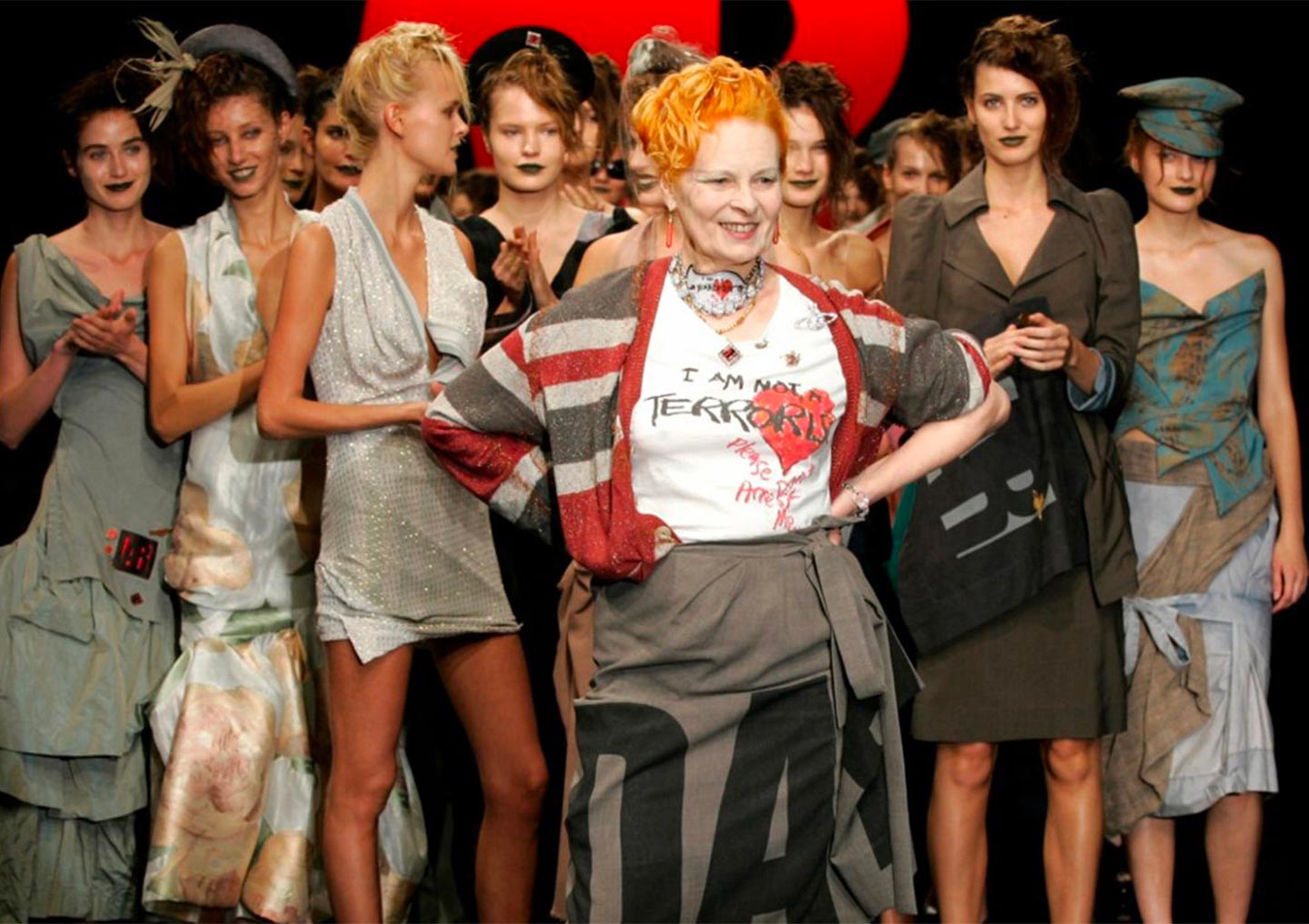
Throughout her career, Vivienne Westwood linked fashion to politics, promoting environmental causes, nuclear disarmament, vegetarianism and efforts to fight climate change
We cannot avoid mentioning that Vivienne Westwood left the fashion industry with an important legacy on social rights, cultures and, most of all, the environment.
Social rights: Vivienne Westwood’s fashion language
When Vivienne Westwood met her partner Malcolm McLaren, manager of the band Sex Pistols, he was under the influence of a group of political activists that, in the 1950s, combined their protest with art forms calling themself the Situationists Internationals, resembling what the Surrealists and Dada were doing in the 30s (Geczy, A., & Karaminas, V. (2018) Critical Fashion Practice: From Westwood to van Beirendonck). This interaction of politics and art shaped the creation of Vivienne Westwood’s most iconic street-style and controversial outfits, such as the earliest T-shirts with radical slogans still part of the Westwood collection.
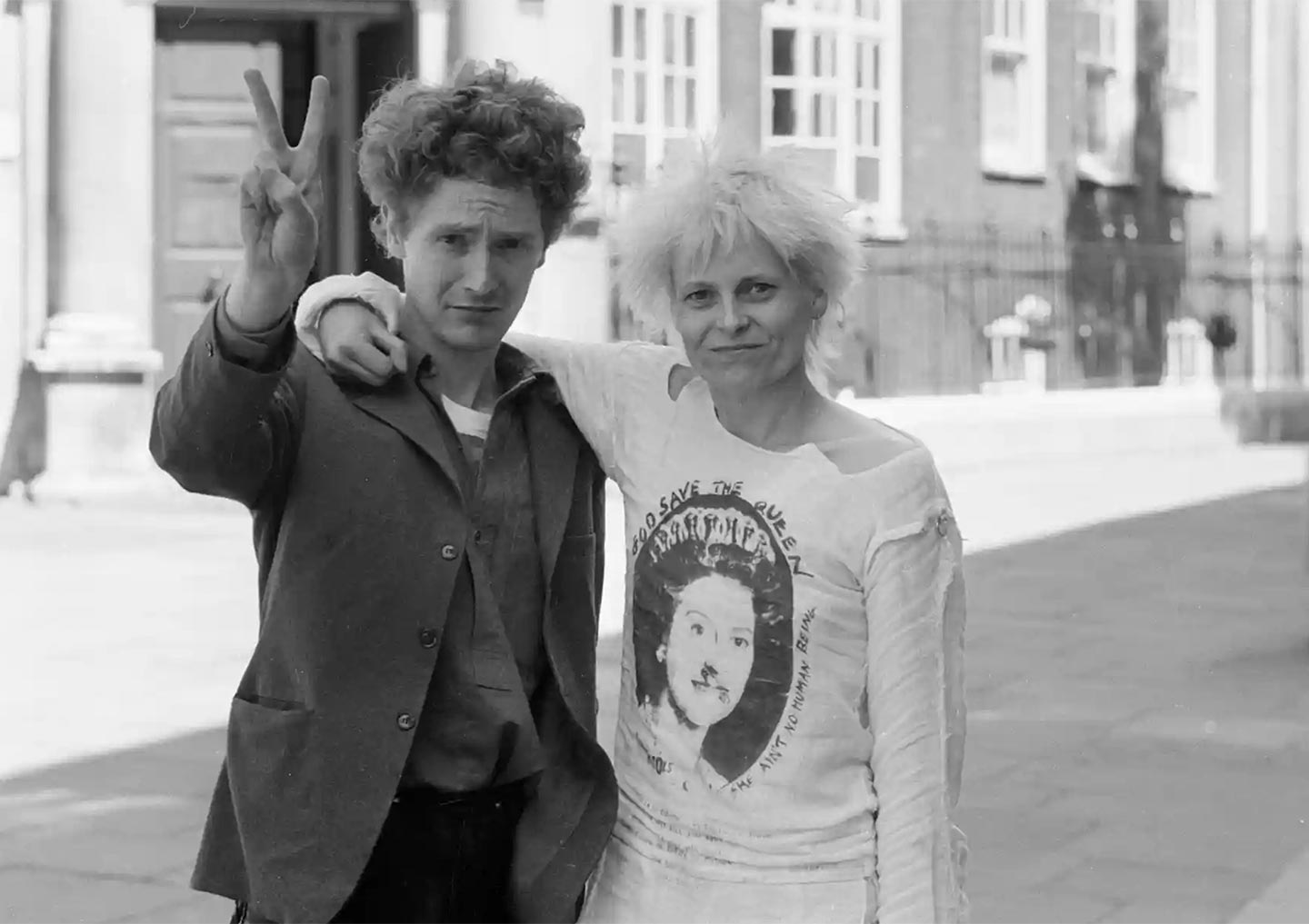
Punk rock group Sex Pistols manager Malcolm McLaren and Vivienne Westwood are seen here outside Bow Street Magistrates’ Court after being remanded on bail for fighting
On the “God Save the Queen” T-shirt designed for the Sex Pistols in 1977, Vivienne Westwood closed Queen Elizabeth II’s mouth with a safety pin with the slogan “She ain’t no human being.” The T-shirt carried a direct, explicit message against the British ruling governor – the monarchy. In some ways, Westwood’s design recognised the Queen of England as a social establishment but never as the British standard of morality and social status.
With clothes, Vivienne Westwood wanted to “transcend definitions of class, gender, ethnicity, and sexual orientation,” as Rebecca Arnold wrote in the volume The Berg Companion to Fashion. Arnold reported Westwood’s strive to “construct new personae for future cultures that draw upon idealised visions of the past inspired by portraiture and film” (Arnold, 2010).
The lesson is simple, Vivienne Westwood knew the history symbols could not be forgotten or rewritten, but the past could be faced. No censure, no words shall be erased but fought with culture. The oppressive symbols shall be cut into pieces, eaten and digested to make something new. Unforgettable was the Tatler magazine cover in 1989 that shocked London fashion week. It pictured Westwood dressed up as The Iron Lady, alias the then-Prime Minister Margaret Thatcher.
This is what Vivienne Westwood did - clothes were a language Westwood used to deconstruct cliché and conventions (Polan, B., & Tredre, R., 2020, The Great Fashion Designers).
Nevertheless, or precisely because of this, Vivienne Westwood was awarded the Order of the British Empire (OBE) in 1992 for her contribution to British fashion history.
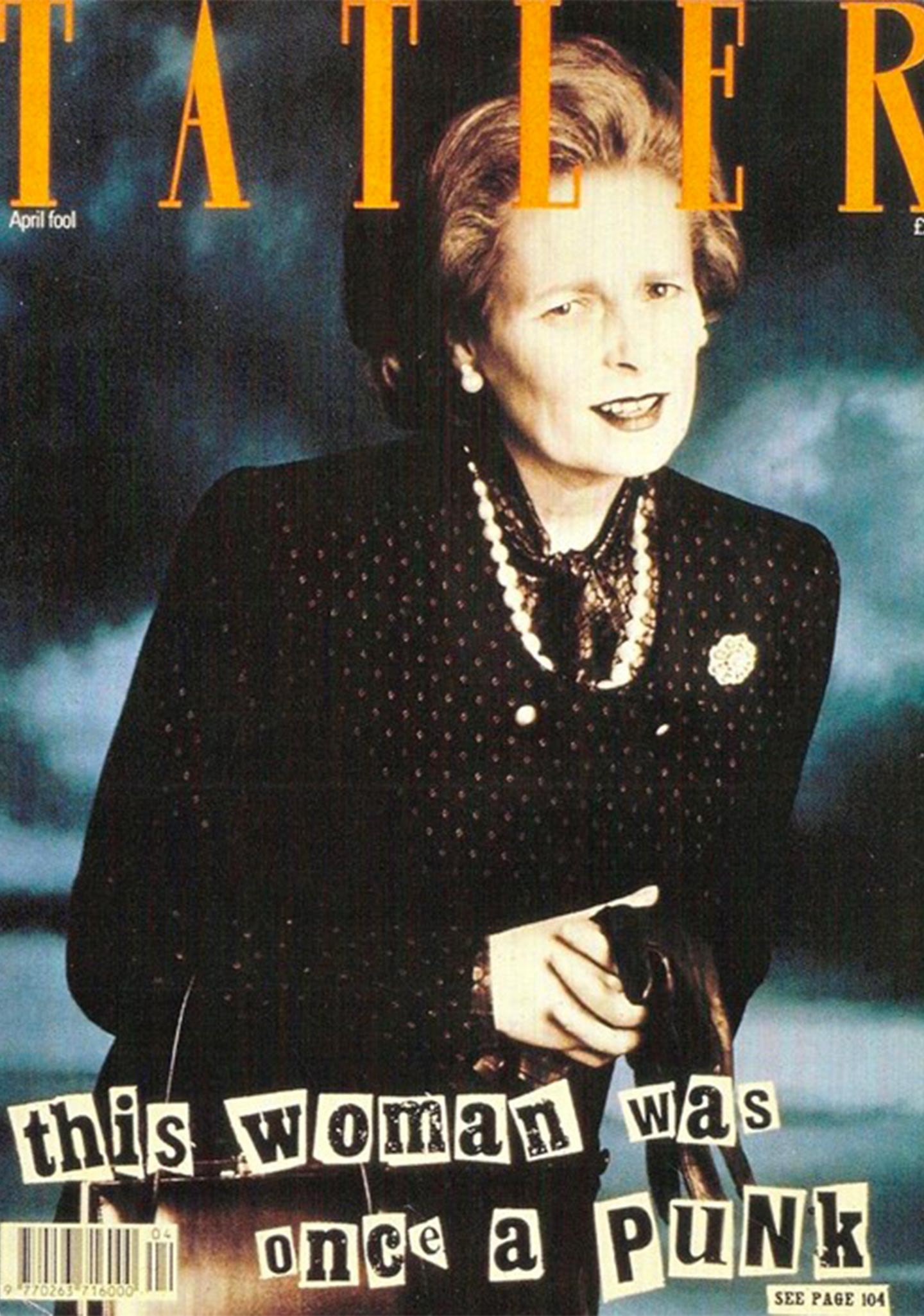
“This woman was once a punk” – Vivienne Westwood as Margaret Thatcher for Tatler’s April 1989 cover
Culture: “The best fashion accessory is a book,” once stated the designer, committed activist and anti-establishment maverick
“I never look at fashion magazines. I find them incredibly boring. To me, reading a fashion magazine is the last thing I need to do. I’ve got books I need to read. More people should read books. It’s the most concentrated experience you can have” – Vivienne Westwood
Before becoming a global fashion designer, Vivienne Westwood was trained as a teacher, and the pedologist aspect structured her creativity freedom – ideas and analysis excited her (Polan, B., & Tredre, R., 2020, The Great Fashion Designers). Undoubtedly, she firmly expressed her love for the history of culture throughout her collection design.
Award-winning biographer Ian Kelly affirmed that Vivienne Westwood was “an unashamed cultural elitist.” Together with Kelly, Westwood published her memoir in 2014, titled Vivienne Westwood. In a chapter of the book, Ian Kelly explained why fashion was never just clothing for the designer. “The only thing I really believe in is culture,” said Westwood. “There has never been an age where people have had so little respect for the past” (Westwood, V. and Kelly, I. , 2014). Westwood also believed that education made people less manipulable by society and, therefore, rebel.
Ian Kelly recalled that after the end of the relationship with Malcolm McLaren and the punk revolution, Vivienne Westwood travelled and visited art galleries, read and learnt from the past of fashion, transferring all her knowledge on clothes designed in the 1980s.
In 2004, the Victoria and Albert Museum in London presented a retrospective exhibition titled “Vivienne Westwood: A Taste For The Past.” There, designer clothes were shown in dialogue with art recalling themes of heritage and culture. If Vivienne Westwood referenced historical styles and was renowned for her parodying of English looks, she also believed in education as a powerful weapon – in a way, this was punk.
“I take something from the past that has a sort of vitality that has never been exploited – like the crinoline – and get very intense. In the end you do something original because you overlay your own ideas” – Vivienne Westwood
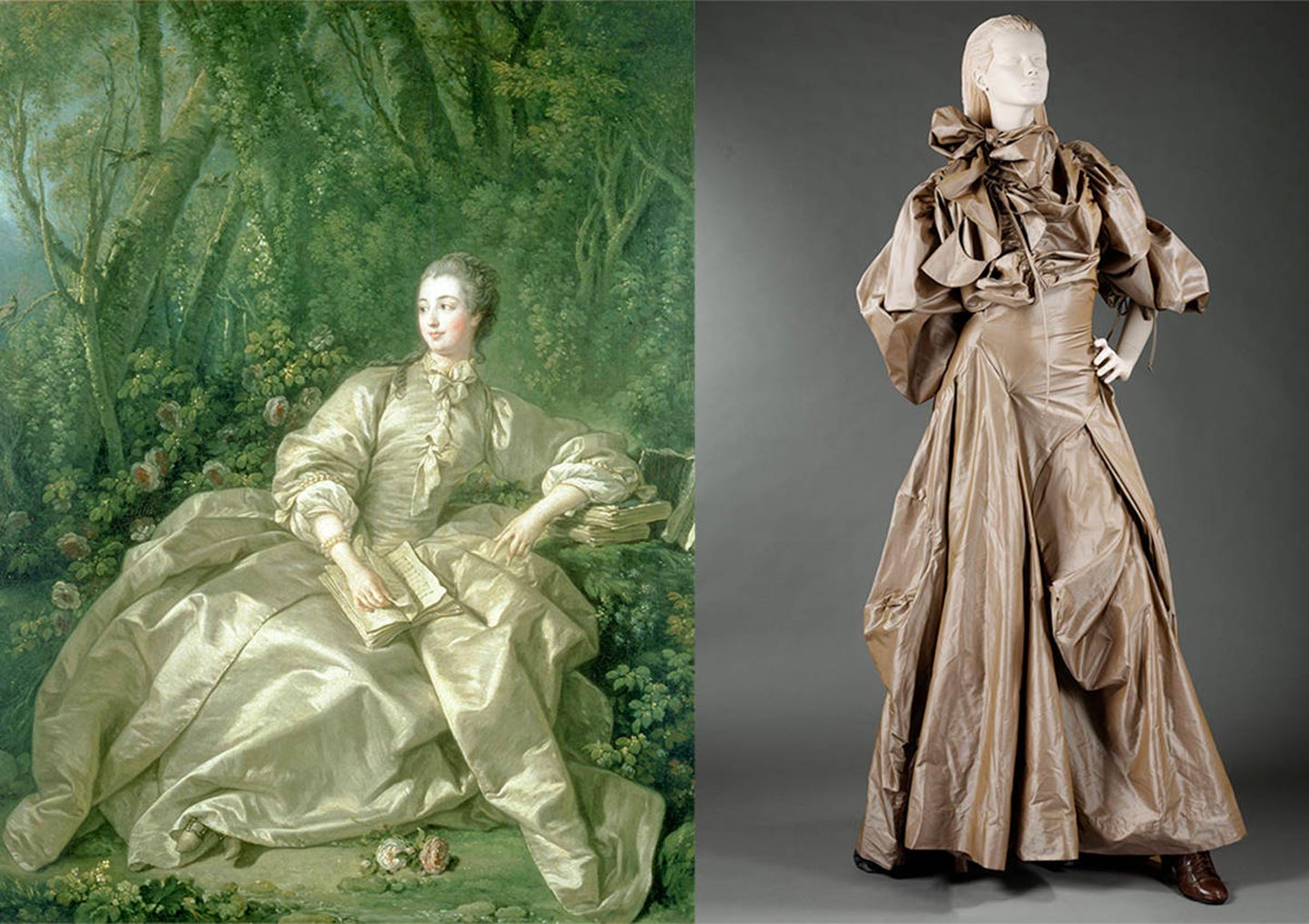
Left to right: Madame de Pompadour, Mistress of Louis XV, François Boucher, 1758, France. Museum no. 487-1882. © Victoria and Albert Museum, London. Anglophilia evening dress, Vivienne Westwood, 2003, England. Lent by the designer for the 2004 exhibition “Vivienne Westwood: A Taste For The Past”
To the artisans who worked with her, Westwood used to say that with clothes, “you can play, taking any decision. This has been the game of clothes over the centuries” (Westwood, V. and Kelly, I., 2014).
Ian Kelly recognised the great research that Vivienne Westwood dedicated to the clothes creation, above to be provocative, photogenic and visually appealing. It was a new statement of fashion: “a personal journey through the history of art,” as Kelly said while underlining that Westwood’s inspiration was not just about western art but also exploring Asia and South American art.
Retrospectively, the 1980s was Vivienne Westwood’s most creative period. She recalled the past power to inspire the present and impressed a whole new constituency: “Vivienne saw it as punk” (Westwood, V. and Kelly, I., 2014).
Environment: Vivienne Westwood’s activism and impact to halt climate change
Sustainability has become imperative for the fashion brand Vivienne Westwood under the motto “buy less, choose well, make it last.”
“Buy less, choose well: that’s the maxim. Quality, not quantity. That’s the most environmentally friendly thing you can do” – Vivienne Westwood
A clear, solid and valuable statement, especially from a celebrity in fashion, the industry most responsible for unsustainable production and social inequality: it was a conclusive testimony to Vivienne Westwood’s commitment as a life activist.
Starting from the Vivienne Westwood brand, the designer led the sustainability mission by acknowledging the contradictions of the fashion industry itself – to promote awareness and campaign for a better world. The imperative she pursued has been active on all levels, as stated in the company’s policy statement, which covers the social and environmental impact of materials, the reduction of emission and waste, craft and heritage, packaging, and, most importantly, activism.
Westwood has always used collections and catwalk shows as a white canvas for her activism campaigns.
For over 20 years, she actively supported global causes collaborating with campaigning movements, NGOs, charities, etc. From 2007, Vivienne Westwood supported the charity CoolEarth.org to protect the global tropical biomes in the Peruvian Amazon and, in 2013, she lobbied the Peruvian government on their Forestry Programme.
“I’ve put my faith in the fantastic charity Cool Earth, which works with local tribes to protect rainforest that is vulnerable to loggers. And the good news is that it works” – Vivienne Westwood
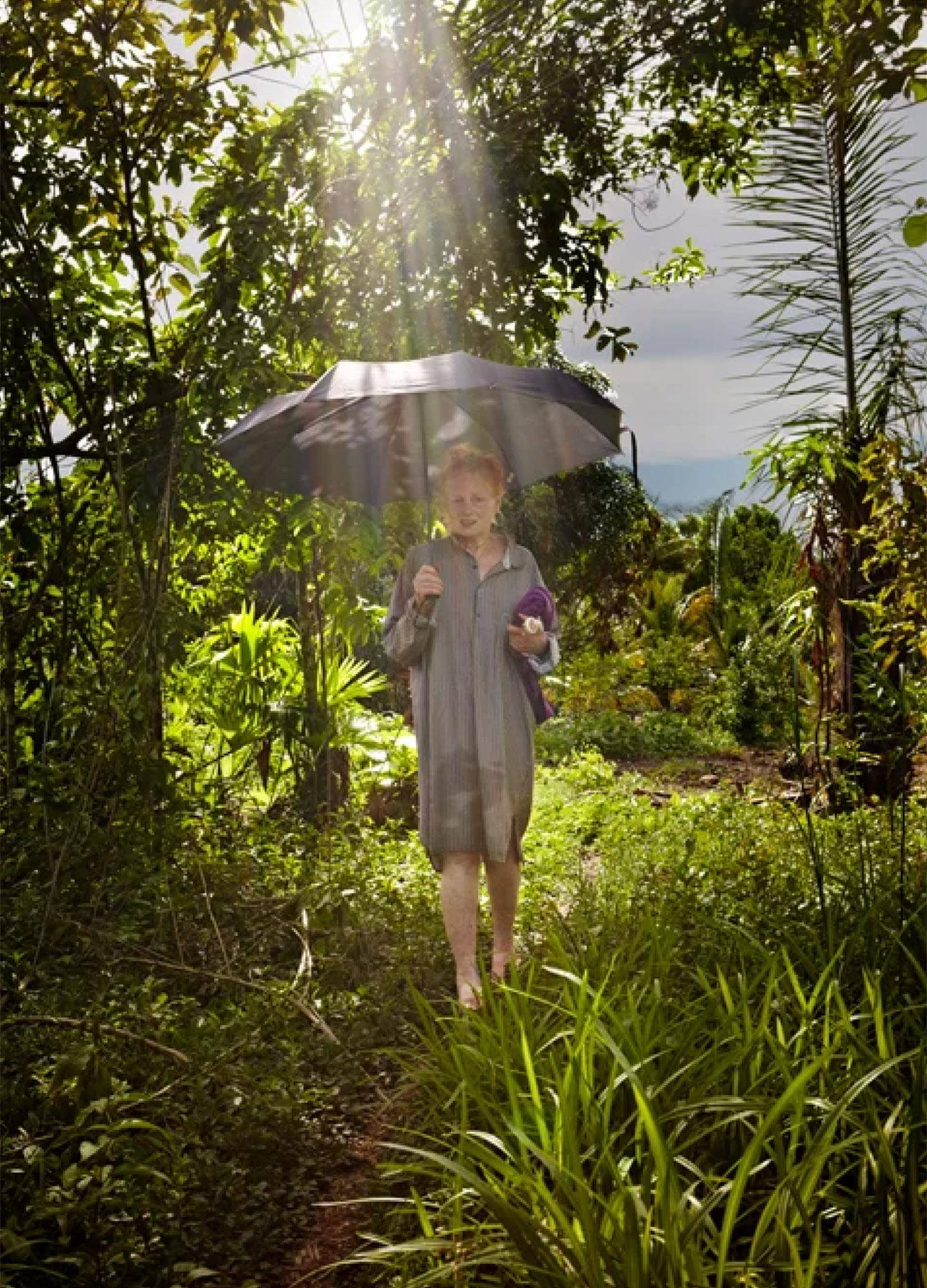
Vivienne Westwood, Cool Earth
The Vivienne Westwood brand web page is not just a collection shop but an informative landing page for their activist initiatives.
In 2010, Westwood’s activist team launched Climate Revolution as a platform documenting daily content and news about activisms and its community and posting Vivienne Westwood’s diaries, letters and YouTube videos from The Vivienne Foundation channel.
Like the avant-garde artists, Westwood perceived the need to write her thoughts down on an activist Manifesto called Active Resistance to Propaganda. The graphics, resembling playing cards, display culture as the stimulus against the ignorance of the financial world. The Manifesto is also free to download and circulate from the Climate Revolution website. The 22-page Manifesto was globally presented at Serpentine Gallery’s Manifesto Marathon in 2008. Read by many personalities, the manifesto is a meditation on the relationship between art and climate change and a critique of consumption and capitalism.
“Dear friends. We all love art, and some of you claim to be artists… I wrote the manifesto a couple of years ago. A few months ago, it hit me. We absolutely must save the rainforests. Have we really got time to be art lovers?” – Vivienne Westwood (2008)
Then in 2010, Vivienne Westwood and Lee Jeans launched an online manifesto installation titled 100 Days of Active Resistance. The website invited people to submit an artwork, slogan or photograph responding to the designer’s conception of “Active Resistance to Propaganda,” in which she argued for culture’s capacity to elevate humanity above self-destruction. Starting on September 8, 2010, for 100 days, one artwork was showcased online daily, ending with an exhibition displaying a selection of the best contributions.
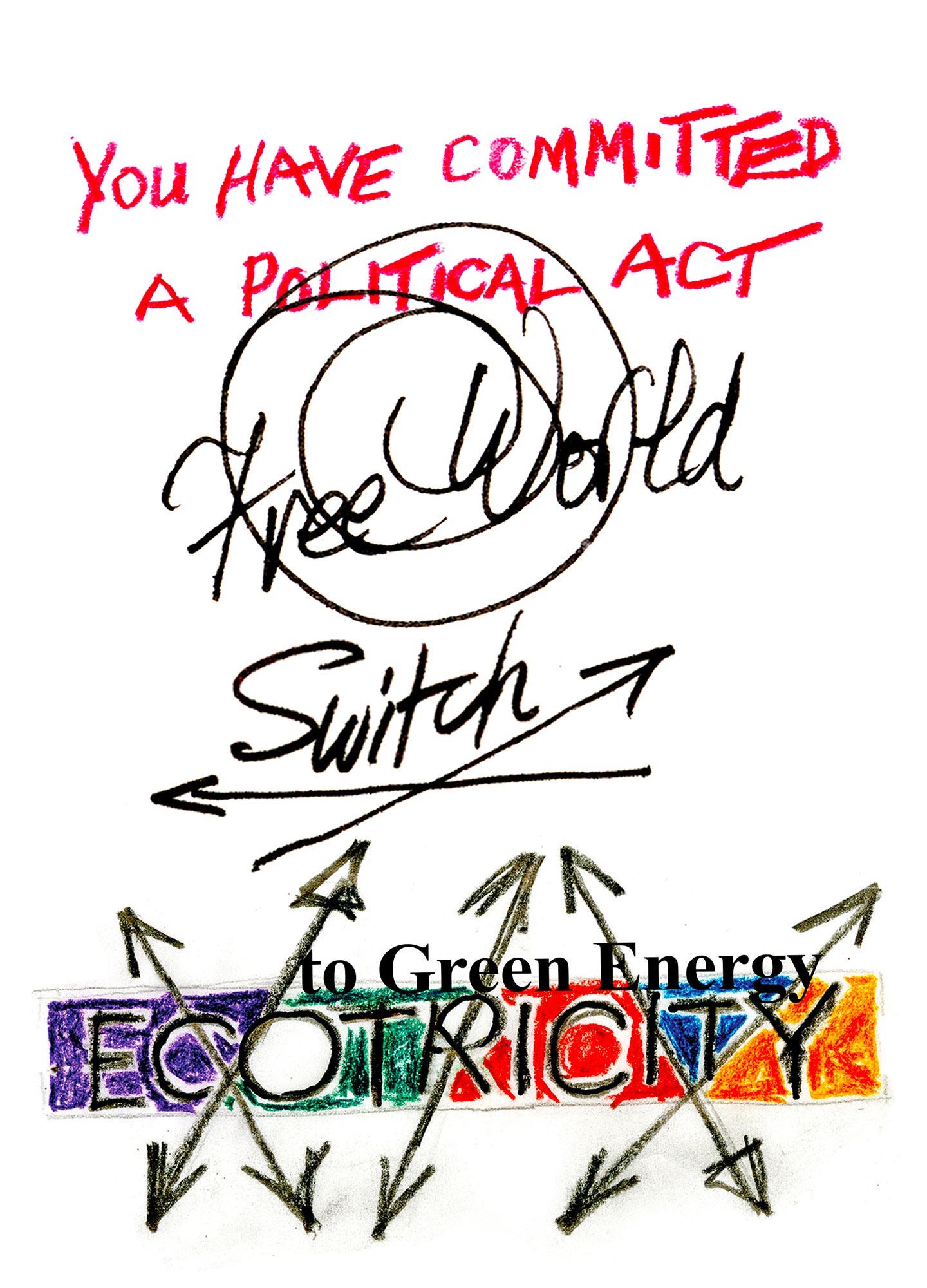
Vivienne Westwood, Manifesto
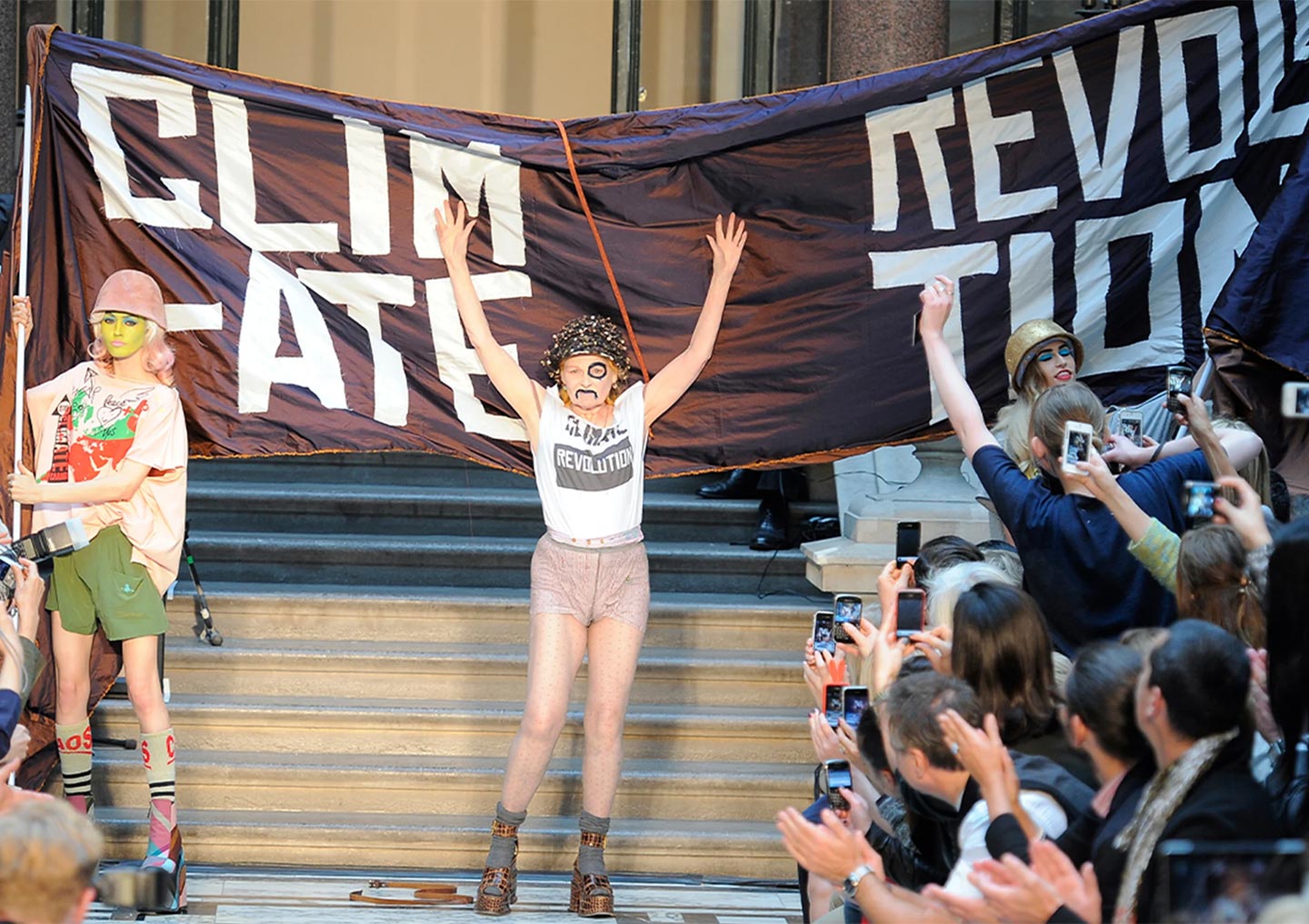
Vivienne Westwood at the end of one of her shows
As the graphics were not enough to speak globally, at the 2012 London Paralympics closing ceremony, Vivienne Westwood and her team walked down in a parade to inaugurate the Climate Revolution movement with a call to collaborate against – the disengaged political leaders and big business.
“I want you to help me save the world, I can’t do it on my own” – Vivienne Westwood
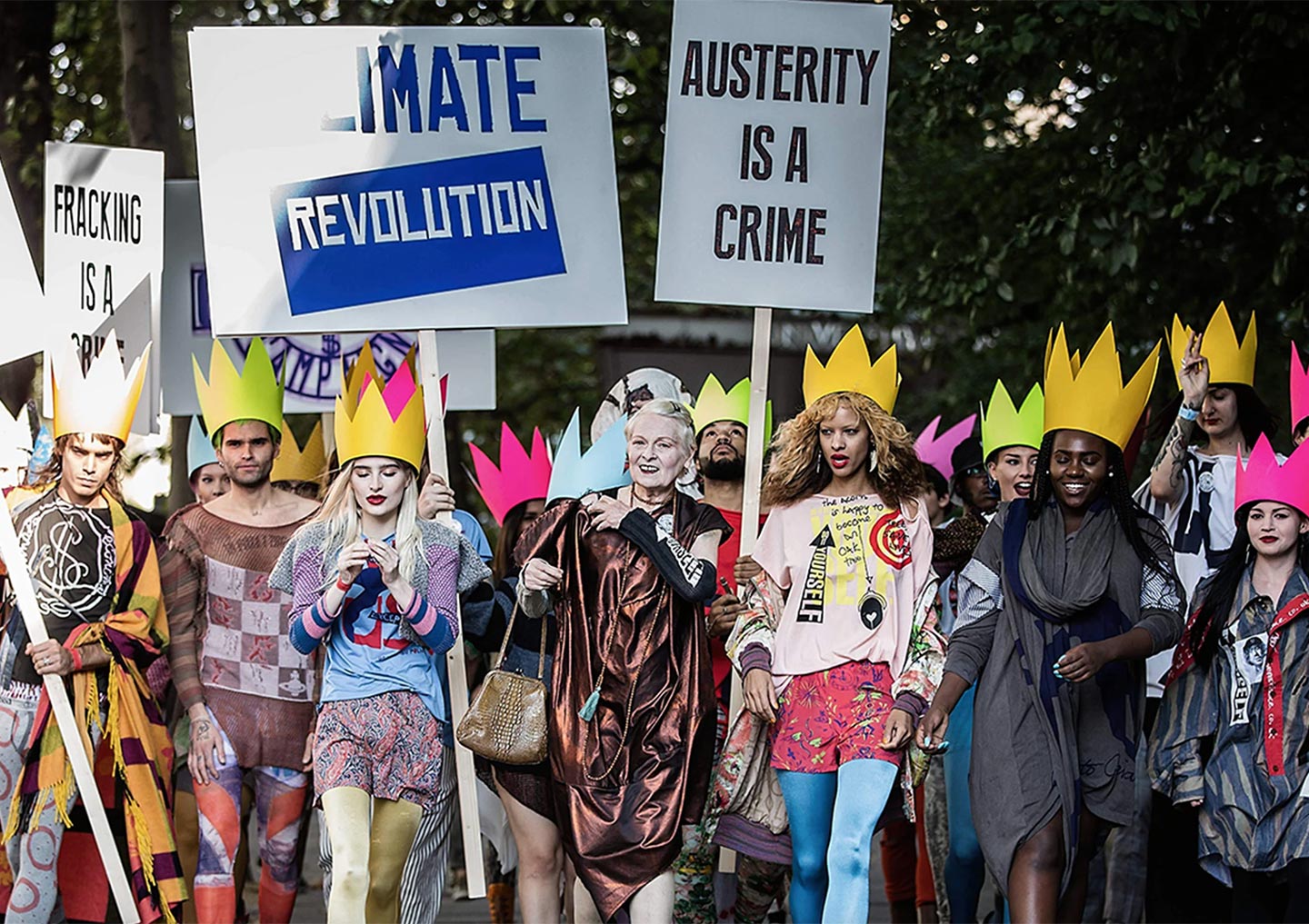
Vivienne Westwood organised several demonstrations to highlight her concerns about climate change and mass production
Another big success was the “Save The Arctic” campaign in 2013. Westwood joined Greenpeace in the site-specific exhibition in the London Waterloo underground, displaying portraits of celebrities wearing the organic unbleached cotton T-shirt to collect profits and awareness on the fragile Arctic drilled by the oil company Shell.
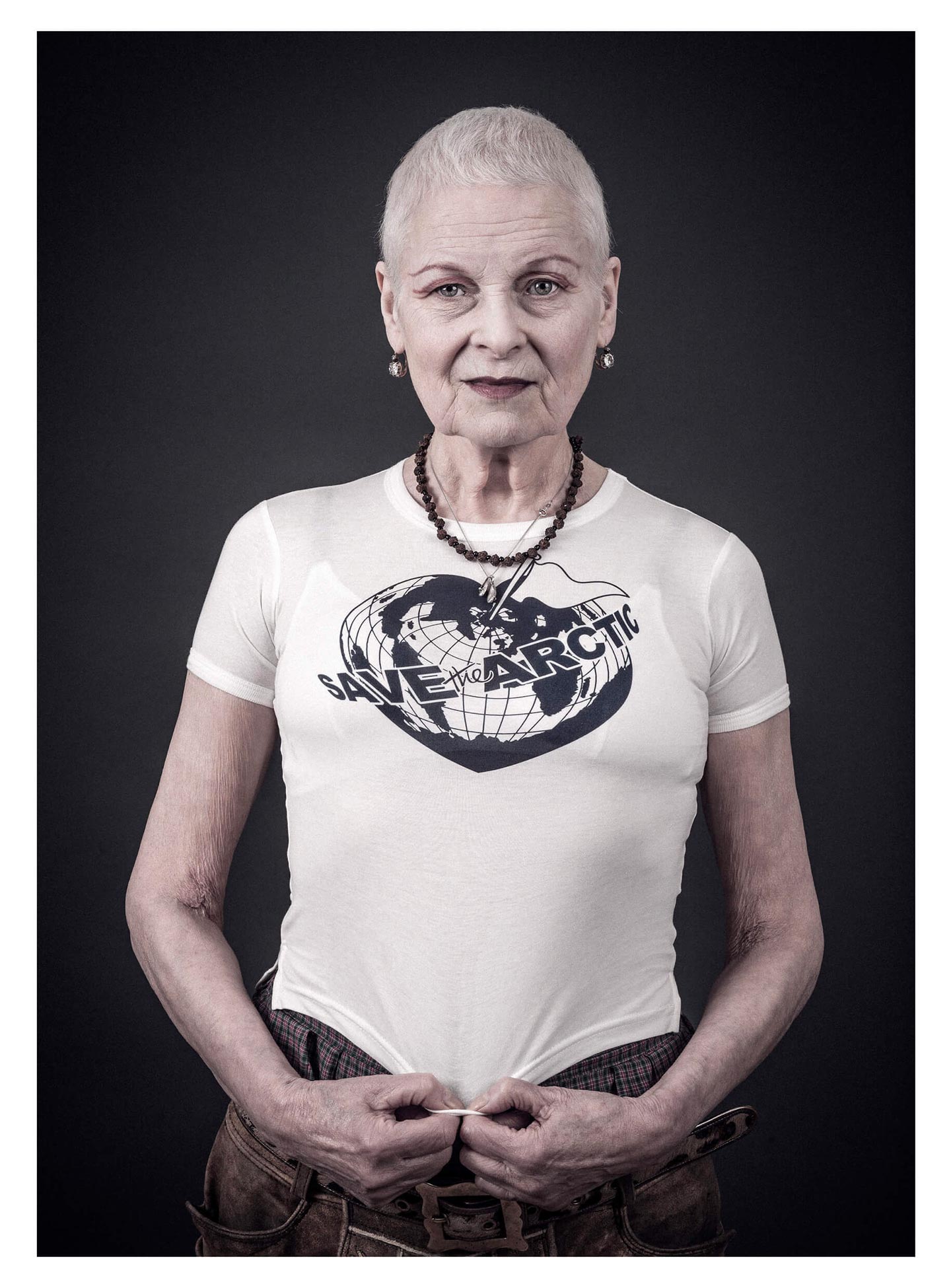
Vivienne Westwood, Greenpeace’s Save The Arctic campaign
Over the last decade, Vivienne Westwood’s sustainable commitment collected more governmental involvement. In 2017, another ambitious action was taken. The “Fashion SWITCH to Green” campaign led by Vivienne Westwood, the British Fashion Council, the Mayor of London, and influential British designers (Oliver Spencer and Stella McCartney, among others) acted as change makers. The aim was imperative: to encourage the fashion community to switch to renewable energy to reduce their impact on CO2 emissions and electricity usage. Acting alone was not enough for the purpose; a long and deep-linked collaboration with the creative industry was necessary to make an effective global change.
“First step to save the environment: switch to green energy. We must rely on cooperation and collaboration to maximise our impact and we must act now! What’s good for the planet is good for the economy” – Vivienne Westwood (2017)
In 2021, the SWITCH campaign collaborated with WePresent, the editorial platform of WeTransfer, on Groundwork, a series of monthly deep dives into Back to Earth projects, on show in London at the Serpentine Gallery – in the context of a long-term interdisciplinary programme to address the ongoing climate emergency.
For the collaboration, WePresent published an interview with Vivienne Westwood about SWITCH and the importance of research. In that interview, Westwood recollected the starting point of her personal environmental commitment thanks to a book published in 1962 by the American biologist Rachel Carson, the founder of the ecological movement, titled Silent Spring (The Guardian, 2012). The book was one of the most effective denunciations of the poisoning effect of industrialisation on our planet, the first alarmed voice that generated global activist groups such as Greenpeace.
Vivienne Westwood’s environmental commitment is her legacy to the fashion world. But as Vivienne Westwood knew, “we are proud of the changes we have made so far. We understand there is so much more to do.”
With this scenario in mind, Istituto Marangoni London is breaking ground with an innovative interdisciplinary Responsible Fashion Master’s programme starting in October 2023. We want to innovate new responsible fashion systems that radically rethink fashion for a new Symbiocene era that supports positive change. With this intent, new kinds of fashion practitioners are needed to enable the fashion industry to transition to a responsible and regenerative future.
“You’ve got to invest in the world, you’ve got to read, you’ve got to go to art galleries, you’ve got to find out the names of plants. You’ve got to start to love the world and know about the whole genius of the human race. We’re amazing people” – Vivienne Westwood, designer, punk, icon, activist (8 April 1941 – 29 December 2022)
References:
Arnold, R. (2010) ‘Westwood, Vivienne*’. In V. Steele, V. (Ed.). The Berg Companion to Fashion. Oxford: Bloomsbury Academic.
Geczy, A. , & Karaminas, V. (2018) ‘Vivienne Westwood’s Unruly Resistance’. In Geczy, A. Critical Fashion Practice: From Westwood to van Beirendonck (pp. 9–28). London: Bloomsbury Academic.
Polan, B. , & Tredre, R. (2020) ‘Vivienne Westwood (1941–)’. In Polan, B. The Great Fashion Designers: From Chanel to McQueen, the names that made fashion history (pp. 248–253). London: Bloomsbury Visual Arts.
Serpentine Galleries (2021) SWITCH by Vivienne Westwood. Serpentine Galleries. [Online] https://www.serpentinegalleries.org/whats-on/vivienne-westwood-switch/.
V&A (2011) V&A · Vivienne Westwood: a taste for the past. Victoria and Albert Museum. V&A. [Online] https://www.vam.ac.uk/articles/vivienne-westwood-a-taste-for-the-past.
Westwood, V. and Kelly, I. (2014) Vivienne Westwood. London: Picador.
Silvia De Vecchi
University Librarian, London


